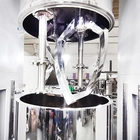Integrating development, manufacturing and sales, as a first-level mixer emulsifier factory.
Overcoming Challenges in Mayonnaise Production Equipment
As the food industry continues to evolve, the demand for mayonnaise as a common condiment is on the rise. However, in the industrial production process of mayonnaise, various challenges often arise, including issues with stability, taste, and nutritional value. Addressing these issues and improving the quality and production efficiency of mayonnaise has become a crucial research topic in the food industry.
I. Stability Issues of Mayonnaise
The stability of mayonnaise is a key concern in industrial production. Due to the high content of oil and egg components in mayonnaise, it is susceptible to oxidation and spoilage due to factors such as temperature and light exposure.
To improve the stability of mayonnaise, several strategies can be implemented:
1. Selecting the right ingredients: Using fresh, high-quality eggs and oils is essential for the stability of mayonnaise. Additionally, choosing suitable emulsifiers and stabilizers based on product characteristics can enhance the stability of mayonnaise.
2. Optimizing production processes: The production processes of mayonnaise significantly impact its stability. Controlling parameters such as temperature, time, and mixing speed is crucial to ensure the uniformity and stability of mayonnaise.
3. Packaging and storage: Proper packaging and storage methods can prolong the shelf life of mayonnaise. Utilizing well-sealed packaging materials and shielding the product from high temperatures and light exposure are essential.
II. Taste Issues of Mayonnaise
The taste of mayonnaise directly influences consumer acceptance. Addressing taste issues requires a multi-faceted approach:
1. Adjusting the formula: Modifying the formula of mayonnaise, such as changing the types and proportions of oils, adjusting emulsifier and stabilizer amounts, can impact the taste and texture of mayonnaise.
2. Improving production processes: Enhancing production processes by controlling mixing speed, time, and temperature can improve the taste and consistency of mayonnaise.
3. Quality testing and control: Establishing a robust quality testing and control system to regularly assess and adjust the taste of mayonnaise ensures product stability and consistency.
In the emulsification process, selecting suitable temperatures and high-quality vacuum emulsifiers is crucial. For enhanced production efficiency, consider using a mixcore recirculating emulsifier, which offers efficiency several times that of traditional emulsifiers.
Keywords: mayonnaise emulsifier, mayonnaise making machine
In conclusion, addressing the stability and taste challenges of mayonnaise in industrial production involves a combination of ingredient selection, process optimization, and quality control measures. By implementing these strategies, producers can enhance the quality and efficiency of mayonnaise production, meeting the demands of a growing market.














































































































